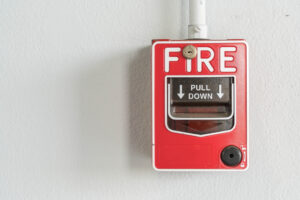Introduction to workplace fire safety
Fire safety is a paramount concern in any workplace, as it directly affects the well-being of employees and the continuity of business operations. By adopting the right behaviors and procedures and taking responsibility for fire prevention, companies can ensure a safe working environment and avoid potential penalties for non-compliance with fire safety regulations. In this article, we will explore essential fire safety tips provided by our experienced EHS consultants to help businesses safeguard their workers and maintain their operations.
Understanding Fire Safety
In Ireland, fire safety is governed by key pieces of legislation, including the Safety, Health, and Welfare at Work Act 2005 and the Fire Services Act (1981 and 2003). Employers have a legal responsibility to implement adequate and appropriate fire safety measures to minimize the risk of injuries and property loss in case of a fire. Failure to comply with these regulations can result in severe consequences, making it essential for businesses to prioritize fire safety.
To reduce the risk of workplace fire incidents and ensure compliance with regulations, companies should take the following steps:
Fire Risk Assessment
Conduct a comprehensive fire risk assessment to identify potential sources of ignition, substances that can fuel fires, and individuals who may be at risk. The assessment should be regularly reviewed and updated to address changes in work activities, processes, premises, equipment, and staff.
Maintain Fire Protection Equipment
Employers should ensure that fire protection equipment, such as fire extinguishers, hoses and fire sprinklers, are correctly installed, tested, and regularly maintained. Adequate fire detection and warning systems, like fire alarm systems and emergency lighting, are crucial in providing early warning and aiding evacuation procedures.
Promote Good Workplace Practices and Behaviors
Encourage a culture of fire safety by promoting responsible behaviors and practices among employees. This includes ensuring proper waste disposal, avoiding the use of unauthorized electrical appliances, and not obstructing fire exits.
Train Employees in Fire Safety
Comprehensive fire safety training for all staff, including temporary and part-time workers, is essential. Training should cover fire hazard recognition, risk assessment participation, fire prevention methods, and effective emergency response strategies.
Fire Risk Assessment
A thorough fire risk assessment is the foundation of a robust fire safety plan. By identifying potential fire hazards and assessing the level of risk, businesses can take appropriate measures to control and minimize these risks.

Identify Fire Hazards
Inspect the workplace to determine potential fire hazards, such as faulty electrical equipment, flammable materials, or poor storage practices.

Assess People at Risk
Identify individuals who may be at risk during a fire, including employees, visitors, and individuals with mobility needs. Special arrangements should be made to ensure their safe evacuation.

Evaluate and Control Risks
Once hazards and at-risk individuals are identified, take appropriate actions to reduce or eliminate these risks. Implement safety measures such as fire-resistant materials, proper storage of flammable substances, and clear evacuation routes.

Routinely Update the Assessment
A fire risk assessment is not a one-time process. It should be updated regularly, at least once a year or whenever there are significant changes in work activities, processes, premises, equipment, or staff.
Developing an Evacuation Plan
An effective emergency evacuation plan is critical in ensuring the safe and orderly evacuation of employees and visitors during a fire emergency. The plan should include the following elements:
-
- Clear Chain of Command: Establish a clear chain of command based on role and responsibility to facilitate efficient decision-making during an emergency.
- Contact Details: Maintain a list of contact details for local emergency services and authorities to facilitate rapid response.
- Emergency Alert System: Implement an effective emergency alert system to quickly notify employees and visitors about the fire emergency.
- Evacuation Procedures: Develop specific evacuation procedures for each area of the workplace and ensure that all employees are familiar with the routes and assembly points.
- Accommodating Special Needs: Make special arrangements for individuals with mobility needs, ensuring their safe evacuation during emergencies.
Safety Equipment and Systems

Fire Detection and Warning Systems
Every workplace must be equipped with a reliable fire detection and warning system. Depending on the type of building and work carried out, this may include smoke detectors, heat detectors, or automatic fire alarm systems. Emergency lighting should also be installed to guide evacuations in case of power failure.

Fire Fighting Equipment
Appropriate fire-fighting equipment, such as fire extinguishers, fire hoses, buckets, and fire sprinkler systems, must be readily available and well-maintained. Regular inspections and testing are essential to ensure their effectiveness in combating fires.
Fire Safety Training and Education
All employees, including temporary and part-time workers, should receive comprehensive fire safety training. The training should empower participants to recognize fire hazards, actively participate in risk assessments, contribute to prevention efforts, and respond effectively during emergencies.
Strengthening the connection with local fire departments and authorities is beneficial. Conducting regular tests and simulations in coordination with these entities helps refine emergency procedures and ensures a cohesive response to fire incidents.
Maintaining a fire-safe workplace is a collective responsibility that requires proactive measures and the adoption of appropriate behaviors and procedures. Understanding fire safety legislation, conducting thorough fire risk assessments, developing evacuation plans, and providing comprehensive fire safety training are all crucial steps to protect workers and keep businesses open. At EazySAFE, our expert Health & Safety consultants can provide specialized training for your staff on fire safety regulations, empowering them to play an active role in preventing fire incidents and promoting a culture of safety in your organization. Prioritize fire safety today to safeguard your employees and the future of your business.

Discover our Safety Training Platform
Train your employees anytime, anywhere with our environmental, health, safety and wellness training platform.

TAILORED TRAINING
Discover our safety training courses and ehs onboardings, which can be customised and offered in several languages.

SAFETY MANAGEMENT
Ensure the distribution of your safety policy by training your permanent, temporary or seasonal staff.

GLOBAL MONITORING
Simplify the management of your safety policy thanks to the numerous dashboards and training reports.
